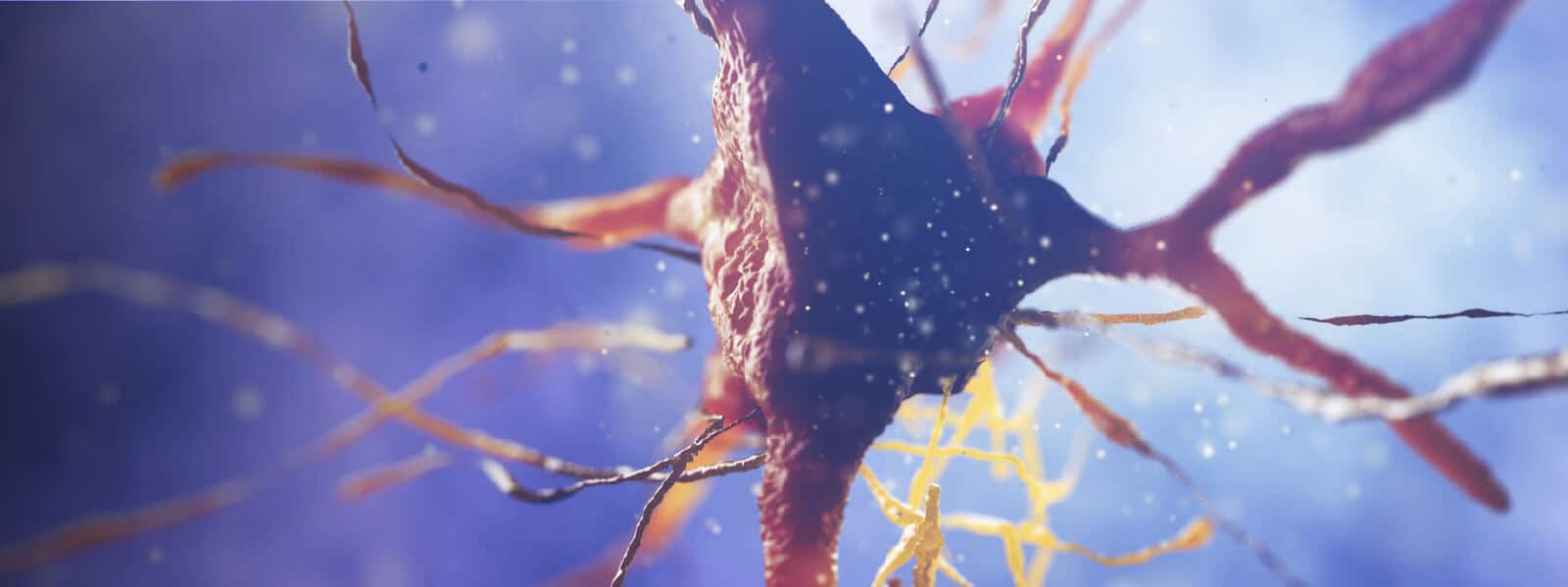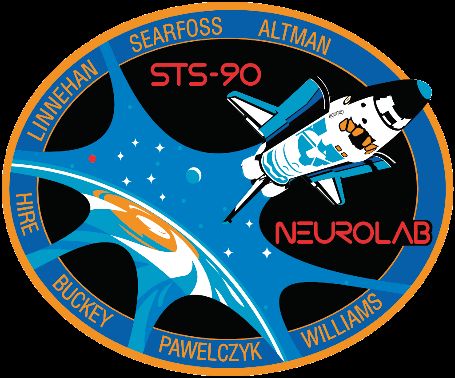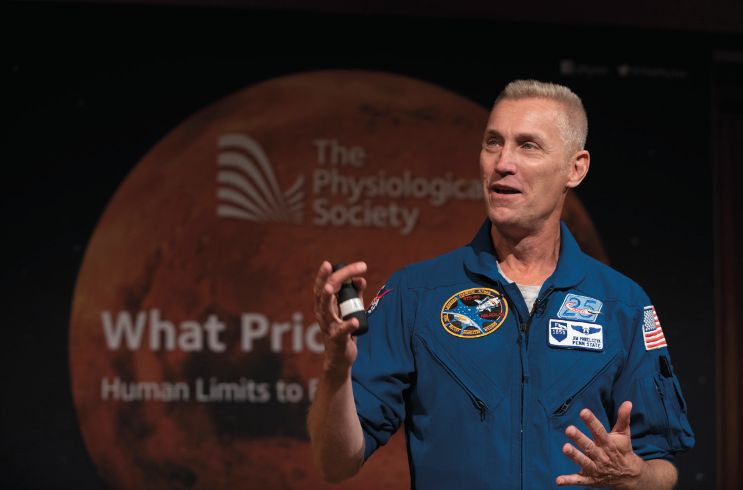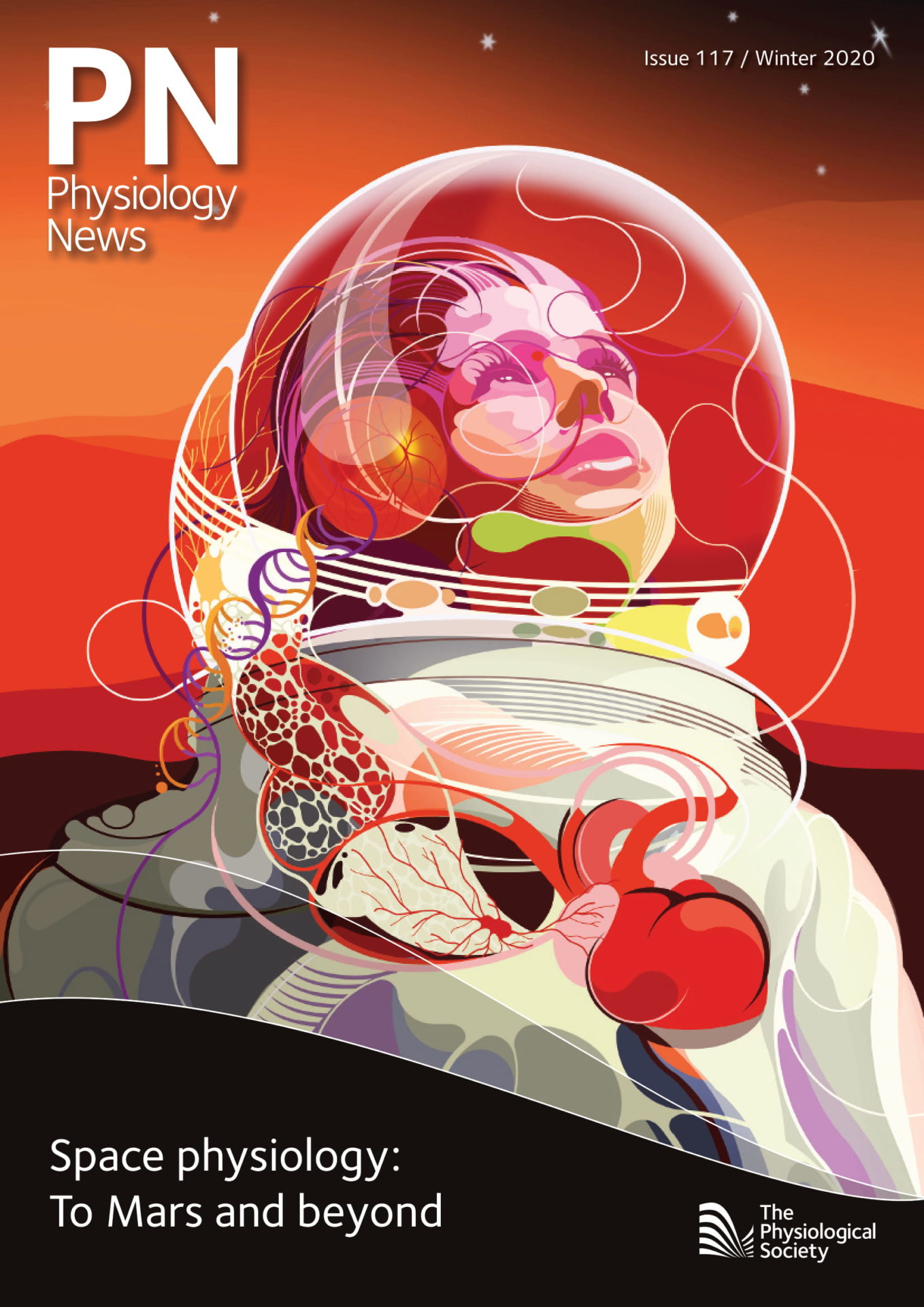
Physiology News Magazine
Physiologist among the stars: A conversation with Jim Pawelczyk
News and Views
Physiologist among the stars: A conversation with Jim Pawelczyk
News and Views
Ronan Berg
Guest Editor, Physiology News
Julia Turan
Managing Editor, Physiology News
https://doi.org/10.36866/pn.117.10

Jim Pawelczyk is one of the very few with the credentials of a physiologist who has also served as an astronaut. In 1996, he took a leave of absence from a position as Assistant Professor of Physiology and Kinesiology at Penn State University, as he was given the chance to enter the NASA astronaut programme. Having grown up in the 1960s in the United States, he had been glued to the television to watch any launch; like many other children of that generation, it was not an opportunity he was going to pass up.
Two years later he spent 16 days in orbit as part of the seven-person crew of Neurolab, the final mission of the European Space Agency developed SpaceLab module flown by the space shuttle Columbia. The flight orbited Earth 256 times, and the crew conducted 26 experiments mainly on the effects of microgravity on the brain and nervous system, serving both as research subjects and operators. Two decades on, Pawelczyk remains an optimist who firmly believes that we will be able to overcome the physiological challenges associated with a manned mission to Mars, so that we can set foot there in the 2030’s. Physiology News met Pawelczyk in London when he was in the UK to give The Physiological Society’s President’s Lecture “What Price a Martian – Human Limits to Exploring the Red Planet”.

Looking back at the Neurolab mission, which was incepted in what President George HW Bush declared the “Decade of the Brain”, Pawelczyk is still thrilled by the results of the experiments that focused on one of his own principal areas of research, the neural regulation of the cardiovascular system. These experiments sought to elucidate the mechanisms of orthostatic intolerance experienced by astronauts after spaceflight, which at the time was widely believed to be caused by a reduction in sympathetic output to the cardiovascular system triggered by prolonged microgravity:
“Our hypothesis was that we were going to have this reversible form of autonomic dysfunction if you will. That is tremendously exciting, at least in theory, because autonomic dysfunction is not reversible. Once you’ve got it, you’ve got it, and all you can do is manage it. So if indeed it was reversible, think what that might mean for those half a million Americans that have problems associated with poor blood pressure regulation.”
In the experiments, the Neurolab crew obtained direct recordings of sympathetic vasoconstrictor nerves and noradrenaline kinetics on each other. But to their surprise, there were no signs of autonomic dysfunction: compared to pre-flight measurements obtained in supine position on Earth, there was actually a slight increase in sympathetic activity. Or as Pawelczyk laconically puts it:
“A beautiful hypothesis ruined by data!”
For Pawelczyk, the results of the Neurolab experiments focusing on the neural regulation of the cardiovascular system fundamentally changed the perception on the adaptive responses of the autonomic nervous system to prolonged microgravity, and were subsequently published in three back-to-back papers in the January issue of The Journal of Physiology in 2002.
To this day, Pawelczyk remains a dedicated advocate for the continued research on the impact of the space environment of the human body, and has testified before the US Senate on several occasions, arguing in favour of funding and conducting such studies on astronauts at the International Space Station. Pawelczyk explains why he considers research in space so important:
“In my opinion, the main reason is so that we can keep crews healthy to explore further and faster. Having said that, things that we do and learn in space, do ultimately have an effect.”
With reference to the interviewee’s glasses, Pawelczyk elaborates:
“That scratch resistant coating that you have on your lenses was originally created to coat visors of astronauts in flight… NASA engineers said, we’ve got to make sure that we protect these visors because our people need to see well […] when they are outside the vehicle. Somebody else got the bright idea and said, well you know we could take eyeglass lenses on the ground and use the same material to make them scratch resistant.”
Indeed, the problems experienced by astronauts in space are manifold. And while Pawelczyk has studied the effects of prolonged microgravity on the human body as a physiologist, it is thus also a personal experience in his case. Perhaps somewhat surprisingly, a main problem experienced
by the astronauts, including the Neurolab crew, was back pain. Many consider this
to be related to the marked elongation of the unweighted spinal column – indeed astronauts usually “grow” several inches taller during missions. Pawelczyk’s experience was, however, quite different. One night, while sleeping in his sleeping bag which he had tied to a rail in SpaceLab, he woke up “with the worst back ache of his life”:
“It was terrible. […] You are sleeping with gravitational forces not really acting on you, so that the body posture that you assume is not defined by gravity, but by muscle tone.”
It turned out that the gluteal muscle group was the culprit:
“The gluteus has muscle tone, so you sort of create this big lordotic curve when you’re in space, so you’re arching your back. And guess what? You wake up in the middle of the night with a big back ache. So the answer to that is you bring your knees up and you put a strap around your body, keep your knees up in position. Maintain more of a natural, normal curvature of your spine – and then everything is fine.”
As our conversation comes to an end, Pawelczyk reflects on what advice he’d give to young physiologists out there – who may or may not become astronauts:
“[…] I think particularly for budding physiologists, always be curious. The most wonderful thing about physiology is that we are confronted with it every day, every moment, because we’re physiological beings. We are a discipline that asks ‘why’ and ‘how’ all the time, relentlessly, and we should never stop asking or trying to answer those two questions.”
Jim Pawelczyk was born in Elma, New York, USA, in 1960. He graduated with a BA in biology and psychology from the University of Rochester (1982), followed by a MSc in physiology from Pennsylvania State University, and PhD in biology/physiology at the University of North Texas (1989). Following a postdoctoral fellowship in cardiovascular neurophysiology at the University of Texas Southwestern Medical Center (1989 – 1992), he became Assistant Professor of Medicine at the University of Texas Southwestern Medical Center and Director of the Autonomic and Exercise Physiology Laboratories at the Institute for Exercise and Environmental Medicine and Presbyterian Hospital of Dallas (1992 – 1995). Since 1995, he has served as Assistant, and now Associate, Professor of Physiology and Kinesiology at the Penn State University. In 1996, he started astronaut training at NASA, and from 17 April to 3 May, 1998, he spent 15 days 21 hours and 50 minutes in space as part of the payload crew on the space shuttle Columbia.
